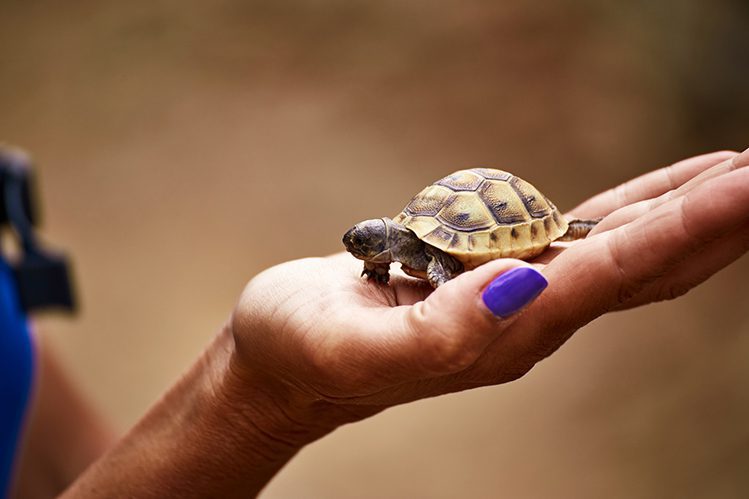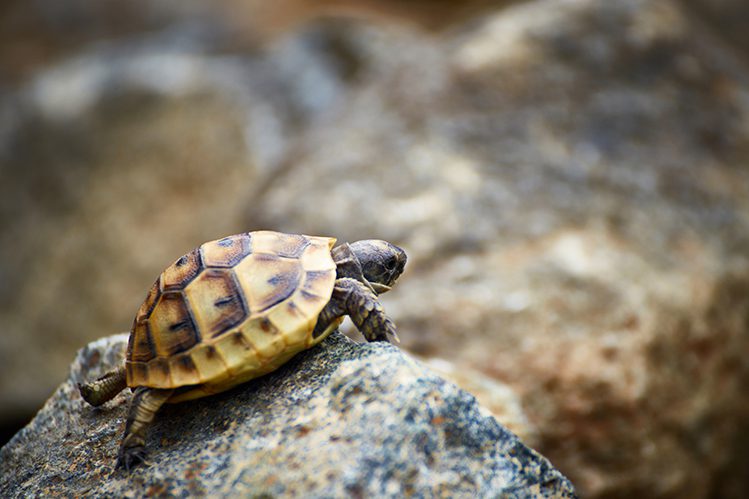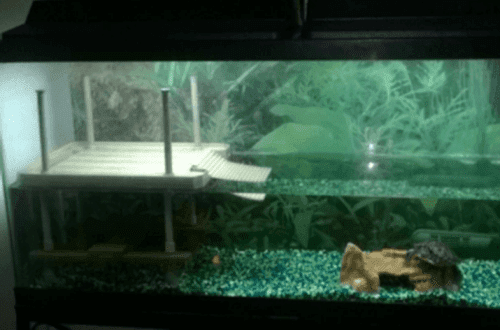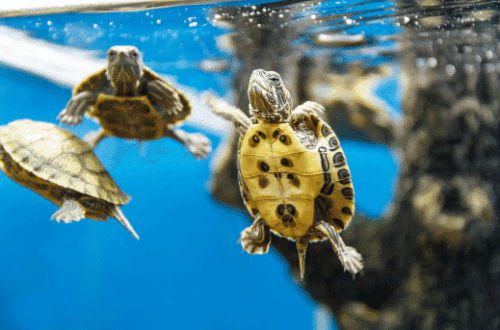
Land tortoise at home: where to buy, how to care for and whether it is worth starting at all
What to prepare for when buying a pet in a shell, explains professional herpetologist Lyudmila Ganina.
The land turtle creates a special atmosphere at home and pleases the owners for many years. But in order to equip her with a cozy home, you will have to try: you have to create a whole world for an exotic pet. It’s easy for beginners to get confused and confused. But not everything is as difficult as it seems.
In this article, we will take a step-by-step look at how to choose a turtle, prepare an apartment for it and avoid popular mistakes that will result in unnecessary expenses or harm your pet.
How to get started with a land tortoise
In order not to be mistaken with a pet, I recommend starting acquaintance with a variety of turtle long before acquiring it. To do this, it is a good idea to carefully study the professional literature and media about the life of the land tortoise in the home and in the wild. This will help you better understand the needs of your pet and make an informed decision: are you sure you are ready for such a responsibility.
Before buying a turtle, do not trust only texts and videos. Chat with the breeder of pets of the breed you are interested in – ask your questions. If the breeder advises you reluctantly, this should alert. Responsible breeders are always rooting for their “graduates” and are interested in preparing the owner.
Ideally, chat with people who already have such a turtle. Ask them about the pitfalls: what they were not ready for in caring for a pet, which turned out to be the most difficult. I don’t advise you to completely transfer someone else’s experience onto yourself, but such a conversation will definitely help prepare for possible surprises.
So that you don’t miss the most important thing in preparation, I have put together a checklist for you on how to choose the right turtle:
Study in the wild and at home: exactly whether she will be comfortable in the apartment.
Read the forums and: what difficulties the owners face.
Study the diet:.
Find a good breeder through reviews and recommendations. Get to know him and ask questions.
Discuss with the breeder and the shopping list: what you definitely need and what you can save on.
with everything you need. Do not forget about equipment, food, vitamin and mineral supplements.
Answer yourself the question: “Am I really ready (a) to start a land tortoise of this breed now?”. If there is even a slight doubt, it is better to refuse even at this final stage of preparation. And if you answered “yes”, you can safely go after the turtle!
After purchasing a pet, keep in touch with the breeder. In which case, you can contact him for expert help. This is especially important when you first get a turtle.

The main thing is to find the right breeder. If the breeder does not take good care of the turtle, after moving to a new home, it may become ill. Unfortunately, such turtles die quickly, and the owners worry that they did something wrong, and it takes them a long time to recover. Anyone can get a pet after this. Next, I’ll tell you how to avoid it.
On forums and websites, you will see a huge number of offers for the sale of land turtles. Some breeders set a low price and are ready to give their pets to any hands, while others “break the price”, and even require a photo of the finished terrarium.
My advice: choose the latter. Such breeders are sincerely interested in the welfare of their pets and will always be in touch. They will help you purchase the necessary equipment, make up a diet and provide all kinds of support – if you want it.
Before buying, you have to study a lot of information about land turtles at home. And I will make this task easier for you and answer 5 questions that I get asked especially often. Chances are you’ll run into them too.
- Should pet turtles hibernate?
The Central Asian tortoises and Mediterranean tortoises that are familiar to us in nature hibernate in the winter, and the Central Asian tortoises also hibernate in the summer. This is due to the climatic features of the habitat of these animals. In captivity, when the season changes, turtles feel the change in daylight hours and jumps in atmospheric pressure and often try to hibernate: they refuse food, become lethargic, and do not leave the shelter.
Hibernation can harm the turtle! “Laying” is possible only for absolutely healthy pets, with a normal supply of adipose tissue and not dehydrated. If your turtle is not ready for the winter, it can become seriously ill or die.
It is safer to introduce a turtle into hibernation gradually, creating a fairly cold temperature of 4-10 degrees and high humidity. The turtles will then need to be weighed regularly and their weight loss monitored. And then – gradually withdraw from wintering.
For a beginner, wintering a turtle is a difficult and risky process. I recommend that you don’t do this. It’s easy: just keep the terrarium at normal temperature. If, despite the optimal “summer” conditions, the turtle is going to spend the winter, show it to a veterinarian. If everything is fine with the turtle, you can arrange a “soft” wintering: turn off the heating and lighting for about a month and curtain the terrarium from room lighting.
- Is it true that land tortoises are vegetarians?
Nearly. Their diet is 95% plant based and 5% animal based. In the wild, they are quite active and able to travel considerable distances in order to obtain a variety of food for themselves. So a rich fortified diet will have to be created for the pet and at home.
- What to feed land turtles?
80% of the diet of a land tortoise is greens: dark greens, grass, hay, the darkest types of lettuce.
10% – vegetables such as pumpkin, carrots, zucchini, cabbage, cucumbers, tomatoes, beets. But tomatoes, beets and cabbage can cause diarrhea – it’s better not to give them.
5% – fruits, berries and mushrooms.
Another 5% of the diet of the land turtle is animal food: fodder insects, snails.
As an addition to the basic diet for herbivorous turtles, it is useful for peristalsis to give professional dry food for turtles, bran. But it is better to coordinate the choice of products and any changes in the diet with a veterinarian, so that later you do not treat your pet for digestive problems.
- Do I need calcium and vitamin D if the terrarium has lamps?
Even if you follow the rules of keeping a terrestrial tortoise accurately and have purchased the best lamps, a tortoise still needs calcium and vitamin D3 for a healthy shell. What kind of complex of vitamins and minerals to buy, ask your veterinarian or breeder.
- Do tortoises need water?
Turtles drink a lot and willingly. The question of liquid intake for turtles is not as acute as for dogs and cats, but without regular drinking, the turtle will become seriously ill. In nature, turtles get the necessary amount of water from plants, raindrops or ponds, and also dig into the ground, digging deep holes to the wet layer. At home, it is enough to organize daily bathing or install a bath in a terrarium. The turtle will drink as much water as it needs, and at the same time absorb it through the mucous membrane of the cloaca.

Preparing a home for the turtle is important before you bring it home. When you bring the pet, you will need to calmly adapt, without unnecessary rearrangements, equipment checks and fuss. To do this, repeat the proven algorithm that I derived from my own experience:
Step 1. Choose a place for the terrarium. It is ideal to place it in a quiet area of uXNUMXbuXNUMXbthe apartment where direct sunlight does not fall. It is a dangerous idea to place the terrarium near a radiator, a window and sources of noise.
Step 2. Calculate the size of the terrarium. A terrarium measuring approximately 15 x 50 x 40 cm is suitable for a turtle up to 40 cm. And two such turtles will be comfortable in an area of 100 x 60 x 60 cm. Rectangular and square containers, as well as in the form of a trapezoid, are suitable. The main thing is that it fits in size and you can create a temperature gradient.
Step 3. Prepare the soil depending on the type of turtle. If the turtle is desert, semi-desert or steppe, sandy loam is ideal. You can use large pebbles, but this is inconvenient: such soil does not absorb anything, and small stones can cause tragedy if the turtle accidentally swallows them. For forest and secondary turtles, the ideal soil is compacted forest land. Do not use coconut chips and wood shavings: they are dusty, can be swallowed and cause intestinal blockage.
Life hack. Supplement the soil with large flat rough stones, tiles, the wrong side of ceramic tiles, pieces of ceramic flower pots. All of them warm up well and give off heat to the turtles. And the turtle can grind its claws on them.
Step 4. Place a house in the terrarium. But not where the light from the heating lamp falls. It is necessary that the turtle could choose where she wants to rest: cool or warm.
Step 5: Determine where to feed. It is desirable that it was not under the place of heating.
Step 6. Create heating. To do this, you will need heating lamps. If the room is too cold at night when the heating is turned off, the terrarium can be heated with thermal cords, thermal mats, ceramic or infrared feet. The corner under the incandescent lamp should warm up to at least 35 ° C, and the place of the least heating (next to the house) – up to 25 ° C. To keep the temperature within the desired range, be sure to purchase a thermometer.
Step 7. Install a UV lamp, otherwise the turtle’s body will not synthesize vitamin D3 to the proper degree, and this will lead to illness in your pet. The lamp power should be at least 10.0 for wood turtles and 15.0 for UVB desert turtles.
Step 8. Install the bath. Better in a place of maximum heating or near it. So the turtle can swim and drink water at will.
You can buy all the equipment together or separately in specialized stores or from the breeders themselves. If you are afraid to miss something, at first you can use ready-made kits, which already have bedding, lamps and a house.
The decor will allow you to turn your turtle’s house into a truly exotic piece of wildlife right in your home. But I recommend being careful with it. Turtles have excellent color vision. Artificial greenery or other appetizing small items can be eaten, which is very dangerous for the turtle. No wonder the arrangement of a terrarium for land turtles is considered an art.
That’s all for today. Choosing a breed, equipment and preparing a terrarium from scratch is a great test drive for the owner. At this stage, you will finally understand whether you can take care of an exotic pet or it is better to get a cat. My opinion: Turtles are absolutely amazing. I want you to be convinced of this!





